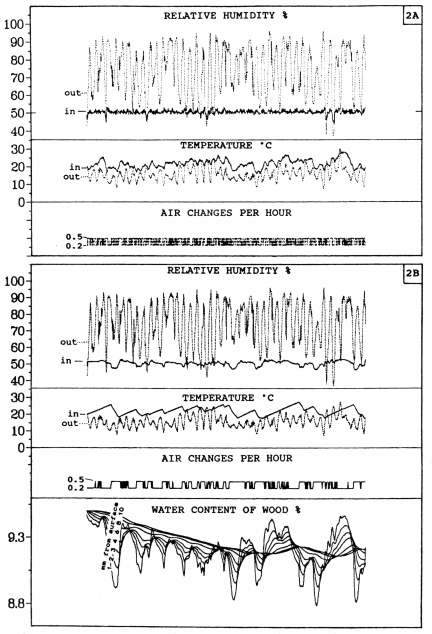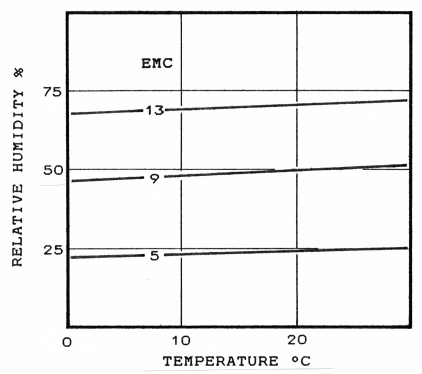
 |
Low energy climate control - 2 |

This method only works where the outside relative humidity is higher than the desired inside RH for most of the time. In our model there is artificial heating but only the natural temperature of the outside air to cool the room. It works well in the lightly buffered room (A). There is considerable waste of energy because periods of heating rapidly alternate with cooling by ventilation.
The method becomes unstable in the heavily loaded room (B). As the temperature rises to try to correct a too high RH the wood desorbs water into the air because its equilibrium water content falls slightly with rising temperature when the RH is held constant (see figure 2C below), so water vapour is released from the wood. This small temperature effect becomes significant when the wood to air ratio is large (the process is described in more detail in reference 6). The temperature continues to rise to compensate for the extra moisture from the wood. the room RH does not fall as intended, as the temperature rises. Eventually, at about 30°C, the incoming air, now heated to a very low relative humidity, provides a drying effect too powerful for the wood to compensate. The RH now drops and the control mechanism opens the fresh air vents to cool the room. The cooling wood begins to absorbs moisture and the fully open air inlet brings in air of inadequate moisture content to give 50% RH at the high temperature. Both processes further dry the air causing a precipitous fall in RH. The system suffers from a sickness known to engineers as "positive feedback".

Fig.2C Relationship between temperature and relative humidity of air in
equilibrium with wood of fixed equilibrium moisture content (EMC). When wood
nearly fills a closed container the relative humidity of the air is controlled
by the wood, which scarcely changes in moisture content during the process. The
relative humidity therefore rises with increasing temperature (following the
lines of constant water content) instead of
falling, as it would in an empty container.
Data from ASTM standard
D 2016-74 (1983)
Climate control by this means is difficult. At a ratio of about one kg of wood to each cubic metre of air there is no change at all in equilibrium RH with temperature. The correct air temperature must be decided by some other method. An alternative heating control is discussed in the next section.

This work is licensed under a Creative Commons Attribution-Noncommercial-No Derivative Works 3.0 License.